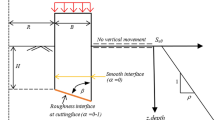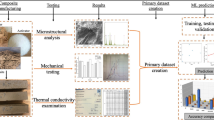Abstract
The California bearing ratio (CBR) value is a pivotal soil characteristic for designing flexible pavements and airport runways. Additionally, it can be harnessed to ascertain the subgrade's soil reaction through correlation. This parameter is paramount in soil engineering, particularly in formulating the subgrade design for rural road networks. The CBR value of soil is subject to a multitude of influencing factors, including but not limited to maximum dry density (MDD), optimum moisture content (OMC), liquid limit (LL), plastic limit (PL), plasticity index (PI), soil type, and soil permeability. Furthermore, whether the soil is soaked or unsoaked also impacts this value. The process of CBR determination is notably protracted and demands a considerable amount of time. Recognizing the significance of this determination, the study introduces an innovative machine-learning approach. This novel method employs a multi-layer perceptron as its foundational model, harnessing the formidable capabilities of this algorithm in addressing regression challenges. To elevate the performance of the MLP and attain optimal outcomes, a hybridization approach has been employed, integrating the Bonobo Optimizer (BO), Smell Agent Optimization (SAO), and Dynamic Control Cuckoo Search (DCCS). The hybrid models proposed in this study showcase encouraging outcomes in CBR value prediction. Notably, the MLAO3 hybrid model emerges as the most precise predictor among the various models, achieving an impressive R2 value of 0.994 and an RMSE value of 2.80.











Similar content being viewed by others
Abbreviations
- \(\mathrm{CBR}\) :
-
California bearing ratio
- \(\mathrm{OMC}\) :
-
Optimum moisture content
- CP:
-
Curing period
- DCCS:
-
Dynamic control cuckoo search
- BO:
-
Bonobo optimizer
- MDAPE:
-
Median absolute percentage error
- WAPE:
-
Weighted absolute percentage error
- LI:
-
Lime percentage
- \(\mathrm{MDD}\) :
-
Maximum dry density
- MLP:
-
Multi-layer perceptron
- SAO:
-
Smell agent optimization
- R 2 :
-
Coefficient of determination
- MSE:
-
Mean squared error
- RMSE:
-
Root mean squared error
References
Abdalla JA, Attom MF, Hawileh R (2015) Prediction of minimum factor of safety against slope failure in clayey soils using artificial neural network. Environ Earth Sci 73:5463–5477
Alawi M, Rajab M (2013) Prediction of California bearing ratio of subbase layer using multiple linear regression models. Road Mater Pavement Des 14(1):211–219
Axel R (2005) Scents and sensibility: a molecular logic of olfactory perception (nobel lecture). Angew Chem Int Ed 44(38):6110–6127
Baghbani A, Nguyen MD, Alnedawi A, Milne N, Baumgartl T, Abuel-Naga H (2023) Improving soil stability with alum sludge: an AI-enabled approach for accurate prediction of California bearing ratio. Appl Sci 13(8):4934
Bhatt S, Pradeep KJ, Pradesh M (2014) Prediction of California bearing ratio of soils using artificial neural network. Am Int J Res Sci Technol Eng Math 8(2):156–161
Buck LB (2004) Unraveling the Sense of Smell. Les Prix Nobel the Nobel Prizes 2004:267–283
Chegenizadeh A, Nikraz H (2011) CBR test on reinforced clay. In: Proceedings of the 14th Pan-American Conference on Soil Mechanics and Geotechnical Engineering (PCSMGE), the 64th Canadian Geotechnical Conference (CGC). Canadian Geotechnical Society
Das AK, Pratihar DK (2019) A new bonobo optimizer (BO) for real-parameter optimization. In: 2019 IEEE Region 10 Symposium (TENSYMP), IEEE, pp 108–13
Ghanadzadeh H, Ganji M, Fallahi S (2012) Mathematical model of liquid–liquid equilibrium for a ternary system using the GMDH-type neural network and genetic algorithm. Appl Math Model 36(9):4096–4105
Ghani S, Kumari S (2022a) Liquefaction behavior of Indo-gangetic region using novel metaheuristic optimization algorithms coupled with artificial neural network. Nat Hazards 111(3):2995–3029
Ghani S, Kumari S (2022b) Reliability analysis for liquefaction risk assessment for the city of Patna, India using hybrid computational modeling. J Geol Soc India 98(10):1395–1406
Ghani S, Kumari S, Bardhan A (2021) A novel liquefaction study for fine-grained soil using PCA-based hybrid soft computing models. Sādhanā 46(3):113
Ghani S, Kumari S, Ahmad S (2022a) Prediction of the seismic effect on liquefaction behavior of fine-grained soils using artificial intelligence-based hybridized modeling. Arab J Sci Eng 47(4):5411–5441
Ghani S, Kumari S, Jaiswal S, Sawant VA (2022b) Comparative and parametric study of AI-based models for risk assessment against soil liquefaction for high-intensity earthquakes. Arab J Geosci 15(14):1262
Ho LS, Tran VQ (2022) Machine learning approach for predicting and evaluating California bearing ratio of stabilized soil containing industrial waste. J Clean Prod 370:133587
Kassa SM, Wubineh BZ (2023) Use of machine learning to predict California bearing ratio of soils. Ad Civil Eng. https://doi.org/10.1155/2023/8198648
Khatti J, Grover KS (2021) Relationship between index properties and CBR of soil and prediction of CBR. Indian geotechnical conference. Springer, pp 171–185
Khatti J, Grover KS (2023a) CBR prediction of pavement materials in unsoaked condition using LSSVM, LSTM-RNN, and ANN approaches. Int J Pavement Res Technol 16:1–37
Khatti J, Grover KS (2023b) Prediction of compaction parameters for fine-grained soil: critical comparison of the deep learning and standalone models. J Rock Mech Geotech Eng. https://doi.org/10.1016/j.jrmge.2022.12.034
Khatti J, Grover KS (2023c) Prediction of soaked CBR of fine-grained soils using soft computing techniques. Multiscale Multidiscip Model Exp Des 6(1):97–121
Khatti J, Grover KS (2023d) Prediction of UCS of fine-grained soil based on machine learning part 1: multivariable regression analysis, Gaussian process regression, and gene expression programming. Multiscale and multidisciplinary modeling experiments and design. Springer, pp 1–24
Kim M, Ordu S, Arslan O, Ko J (2023) Prediction of California bearing ratio (CBR) for coarse-and fine-grained soils using the GMDH-model. Geomech Eng 33(2):183
Kurnaz TF, Kaya Y (2019) Prediction of the California bearing ratio (CBR) of compacted soils by using GMDH-type neural network. Eur Phys J plus. https://doi.org/10.1140/epjp/i2019-12692-0
Mareli M, Twala B (2018) An adaptive cuckoo search algorithm for optimisation. Appl Comput Inform 14(2):107–115. https://doi.org/10.1016/j.aci.2017.09.001
Moayedi H, Hayati S (2018) Applicability of a CPT-based neural network solution in predicting load-settlement responses of bored pile. Int J Geomech 18(6):6018009
Nagaraju TV, Alireza Bahrami Ch, Prasad D, Mantena S, Biswal M, Islam MR (2023) Predicting California bearing ratio of lateritic soils using hybrid machine learning technique. Buildings 13(1):255
Nguyen TT, Truong AV, Phung TA (2016) A novel method based on adaptive cuckoo search for optimal network reconfiguration and distributed generation allocation in distribution network. Int J Electr Power Energy Syst 78:801–815. https://doi.org/10.1016/j.ijepes.2015.12.030
Othman K, Abdelwahab H (2023) The application of deep neural networks for the prediction of California bearing ratio of road subgrade soil. Ain Shams Eng J 14(7):101988
Patel RS, Desai MD (2010) CBR predicted by index properties for alluvial soils of south Gujarat. In: Proceedings of the Indian Geotechnical Conference, Mumbai, pp 79–82
Ramasubbarao G, Sankar SG (2013) Predicting soaked CBR value of fine grained soils using index and compaction characteristics. Jordan J Civil Eng 7(3):354–360
Sakalli E, Temirbekov D, Bayri E, Alis EE, Erdurak SC, Bayraktaroglu M (2020) Ear nose throat-related symptoms with a focus on loss of smell and/or taste in COVID-19 patients. Am J Otolaryngol 41(6):102622
Suthar M, Aggarwal P (2018) Predicting CBR value of stabilized pond ash with lime and lime sludge using ANN and MR models. Int J Geosynth Gr Eng 4:1–7
Taskiran TJAIES (2010) Prediction of California bearing ratio (CBR) of Fine grained soils by AI methods. Adv Eng Softw 41(6):886–892
Varol T, Ozel HB, Ertugrul M, Emir T, Tunay M, Cetin M, Sevik H (2021) Prediction of soil-bearing capacity on forest roads by statistical approaches. Environ Monit Assess 193(8):527. https://doi.org/10.1007/s10661-021-09335-0
Yang X-S, Suash D (2009) Cuckoo search via lévy flights. In: 2009 World Congress on Nature & Biologically Inspired Computing (NaBIC), IEEE, 210–14
Yildirim B, Gunaydin O (2011) Estimation of California bearing ratio by using soft computing systems. Expert Syst Appl 38(5):6381–6391
Zumrawi MME (2012) Prediction of CBR value from index properties of cohesive soils. Univ Khartoum Eng J 2:561
Zumrawi MME (2014) Prediction of in-situ CBR of subgrade cohesive soils from dynamic cone penetrometer and soil properties. Int J Eng Technol 6(5):439
Acknowledgements
This work was supported by "the Key project of teaching and research planning of Anhui Vocational and Adult Education Association, Anhui China(No.azcg44)", "key Research Project of Social Sciences in Anhui Universities, Anhui China(No.2022AH053106) ", "Anhui Provincial Department of Education University Quality Project, Anhui China ( No.2022jpkc041).
Author information
Authors and Affiliations
Contributions
LZ: writing-original draft preparation, conceptualization, supervision, project administration.
Corresponding author
Ethics declarations
Conflict of interest
The author declares no competing interests.
Additional information
Publisher's Note
Springer Nature remains neutral with regard to jurisdictional claims in published maps and institutional affiliations.
Rights and permissions
Springer Nature or its licensor (e.g. a society or other partner) holds exclusive rights to this article under a publishing agreement with the author(s) or other rightsholder(s); author self-archiving of the accepted manuscript version of this article is solely governed by the terms of such publishing agreement and applicable law.
About this article
Cite this article
Zhang, L. Employing multi-layer perceptron model via meta-heuristic algorithms for predicting California bearing capacity of stabilized soil. Multiscale and Multidiscip. Model. Exp. and Des. 7, 1375–1391 (2024). https://doi.org/10.1007/s41939-023-00277-3
Received:
Accepted:
Published:
Issue Date:
DOI: https://doi.org/10.1007/s41939-023-00277-3




